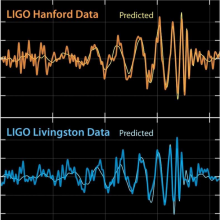
Data analysis is a broad topic that includes how researchers gather, filter, model, visualize and analyze data for the purpose of scientific research. There are numerous methods and approaches to how data may be handled. CCRG members use a number of data analysis techniques to analyze data from simulations and experiments that utilize numerical and analytical relativistic methods. In addition to this, CCRG members also focus on gravitational wave data analysis and its interplay with astrophysical source simulation, like how the results of source simulations of compact objects can be used to design data analyses that extract relevant information from gravitational wave detectors.
Gravitational wave observatories have opened a new window on the universe. As they freely escape from the most energetic objects and events in the universe, gravitational waves encode unique information about them. Decoding that information, we can deduce quite a bit about what was responsible for each observation. Our Gravitational Wave Data Analysis group develops and applies detailed physics-based calculations and statistical tools to interpret gravitational wave and multimessenger observations. We find individual events, measure the properties of the sources responsible, and draw conclusions about the physics responsible for the observed populations. Our data analysis group has three signature programs: identifying signals from rotating neutron stars; measuring the parameters of coalescing compact binaries, particularly through direct comparison of gravitational-wave observations with numerical relativity; and characterizing the population of gravitational-wave sources throughout the universe.
Gravitational wave observatories have opened a new window on the universe. As they freely escape from the most energetic objects and events in the universe, gravitational waves encode unique information about them. Decoding that information, we can deduce quite a bit about what was responsible for each observation.
Our Gravitational Wave Data Analysis group develops and applies detailed physics-based calculations and statistical tools to interpret gravitational wave and multimessenger observations. We find individual events, measure the properties of the sources responsible, and draw conclusions about the physics responsible for the observed populations.
Our LIGO gravitational wave data analysis group has three signature programs: identifying signals from rotating neutron stars; measuring the parameters of coalescing compact binaries, particularly through direct comparison of gravitational-wave observations with numerical relativity; and characterizing the population of gravitational-wave sources throughout the universe.








